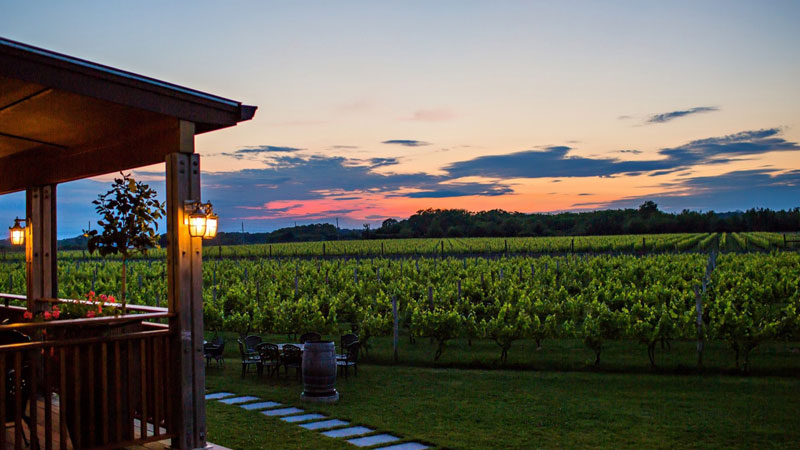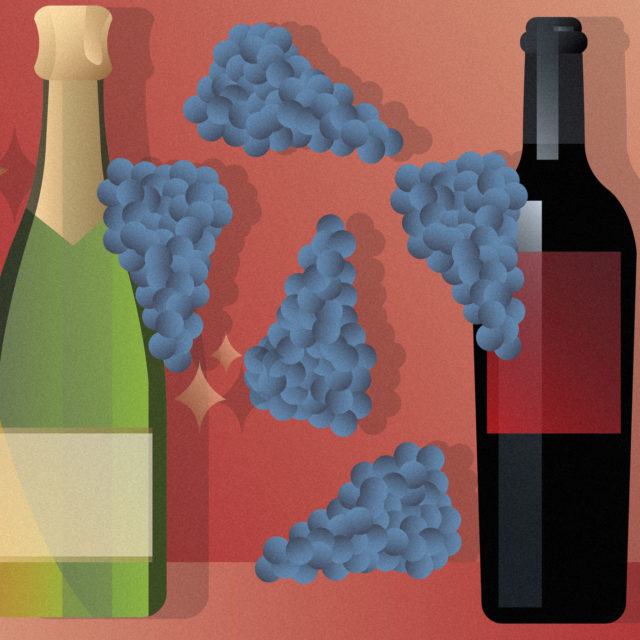Pinot Meunier is best known as one of the three grapes most often used to make Champagne, and typically sits in the shadows of its more popular relative, Pinot Noir. Now, as viticultural techniques and consumer tastes evolve, global winemakers are using it to make varietal wines that are versatile and accessible.
Ruth Simpson, owner of Simpson’s Wine Estate in Canterbury, England, began planting Pinot Meunier in 2014. She says a bottle of single-varietal Blanc de Noirs Pinot Meunier from Germany inspired her and her husband to try cultivating the variety. “We thought it was completely unique and extremely food-friendly,” she says.
The Simpsons hand-pick their Pinot Meunier and carefully whole-bunch press it as they would a white grape variety. Juice settles and ferments, goes through full malolactic fermentation, and rests on the fine lees before bottling.
“It has been very well received and is currently poured in a number of Michelin-starred, gastronomic restaurants in London,” Simpson reports. Still, she says, marketing a Blanc de Noir Pinot Meunier to the general U.K. market can be a hard sell.
Other consumers are drawn to the variety’s relative obscurity. Ernie Pink, co-founder of Oregon-based Amalie Robert Estate, says certain drinkers can’t get enough of the grape’s quirkiness, even if a majority of consumers don’t understand it. After producing a number of Pinot Meunier rosé Champagnes, Amalie Robert winemakers began vinifying it varietally, in still, red form.
“We grow Pinot Meunier the same way we grow Pinot Noir,” Pink says. “We harvest Pinot Meunier about midway through the Pinot Noir harvest. That is when we find the aroma, flavor, and texture to be at its peak.”
Amalie Robert’s Pinot Meunier is 100 percent de-stemmed and fermented with indigenous yeasts, punched down by hand daily, and pressed into neutral barrels for malolactic fermentation and aging. It’s bottled unfined and unfiltered.
Pink believes varietal Pinot Meunier is an excellent food wine, and equally as versatile — if not more so — than Pinot Noir, but notes that it’s not always well merchandised in restaurants. “On a wine list, it is often in the “Other Reds” category with Cab Franc, Gamay, and all the other less familiar varieties,” he says.
He doesn’t think it’s too detrimental, though. For some drinkers, that sense of discovery, of “finding” something not everyone else is drinking, is part of the appeal. “Let’s not try and make it something it is not. We can appreciate it for what it is and the sensory thrill it can provide,” he says.
Kelly Koch, winemaker at New York’s Macari Vineyards, cut her teeth vinifying Pinot Meunier at Bouchaine Vineyards in Napa before moving to the North Fork. “It was always my favorite wine that we made, and I was very excited when I discovered that we had a little bit of Pinot Meunier here at Macari!” she says.
Macari’s Pinot Meunier production is small, spanning less than one acre, but the wines are popular. They are generally only allocated for purchase to wine club members, and sell out the day of release.
“We go through the vineyard and select the best clusters during harvest and sort the fruit in the field so we get nice healthy fruit coming to the crush pad,” Koch says, noting that fruit is de-stemmed, fermented, macerated for two weeks, and pressed into neutral oak for aging. “If we don’t make it into a red wine, we usually press the fruit to include it in our rosé,” she adds.
Gabriella Macari, managing director, says her father planted Pinot Meunier in the 1990s because he wanted to work with all of the traditional varieties of Champagne. “Given our cool-climate growing region, he knew sparkling was something that he wanted to focus on in the future,” she says. “My parents were completely captivated by Champagne and wanted to know for themselves what each grape would bring to a potential blend.” And, unlike Pinot Noir, there’s an “element of lively spice” that makes Pinot Meunier unique, she says.
Of course, cultivating Pinot Meunier isn’t always a walk in the park. “It is difficult to grow given our humid climate — similar to Pinot Noir, with thin skins,” says Joe Macari, vineyard manager. “However, it’s looking great so far this year, as we’ve had a hot and dry summer.”
Disease and rot can also be an issue. Viv Thomson, owner of Best’s Wines in Australia, notes that most Pinot varieties are susceptible to botrytis, due to their tight clusters.
In Australia, varietal Pinot Meunier is formerly known as Millers Burgundy and has been gaining popularity since the middle of the 20th century. Thomson credits its rise to Australian wine drinkers’ increasing sophistication.
Best’s’ Pinot Meunier is dry-farmed and vinified with small amounts of whole bunches, which are hand-plunged, fermented warm, and left on the skins for up to two weeks before basket pressing. It’s aged for eight to nine months in small, French oak barriques.
While global production is relatively small, especially compared to power players like Pinot Noir, varietal Pinot Meunier offers curious drinkers top quality at considerable value.
“From a consumer point of view, this is a fun variety to learn about and can enhance your vinous prowess,” says Pink, noting that some tasters even mistake varietal Pinot Meunier for top-tier Burgundy. Opening consumers’ minds to the variety, whether at events, in tasting rooms, or in restaurants, is the first step. “Wine pairing events are where the big “aha! moments come into focus,” Pink says. “Chefs typically are excited to work with it in tasting menus and winemaker events as it offers an opportunity for their creativity to shine.”
And it’s generally crowd-pleasing, Thomson says. “I had a customer come to our cellar door once and told me that he had opened a bottle of our Pinot Meunier the previous evening and when he looked around it was gone,” she says. “To me, that says it all.”

Four Varietal Pinot Meuniers to Try
Best’s Old Vine Pinot Meunier 2017
Owner Viv Thomson describes Best’s varietal Pinot Meunier as pale-pigmented and soft, with delicate tannins and easy drinkability. Average price: $75.
Amalie Robert Estate 2017
“Our interpretation of Pinot Meunier is a light-bodied, elegant wine with raspberry and rose petal aromas that tantalize and scintillate the palate while finishing up with firm acidity,” says co-founder Ernie Pink. Average price: $32.
Teutonic Pinot Meunier ‘Borgo Pass Vineyard’ 2017
Teutonic Wine Company’s production focuses on cooler-climate varieties from dry-farmed sites in the heart of Oregon wine country. Its Pinot Meunier shows flavors of juicy berries and tart red fruit, marked by a lingering finish. Average price: $36.
Weingut Darting Pinot Meunier 2016
Weingut Darting’s varietal Pinot Meunier is sustainably farmed and comes from Germany’s Pfalz region. On the palate, the wine is round, easy-drinking, and red-fruited. Ten to 20 percent new oak is used during vinification. Average price: $21.
